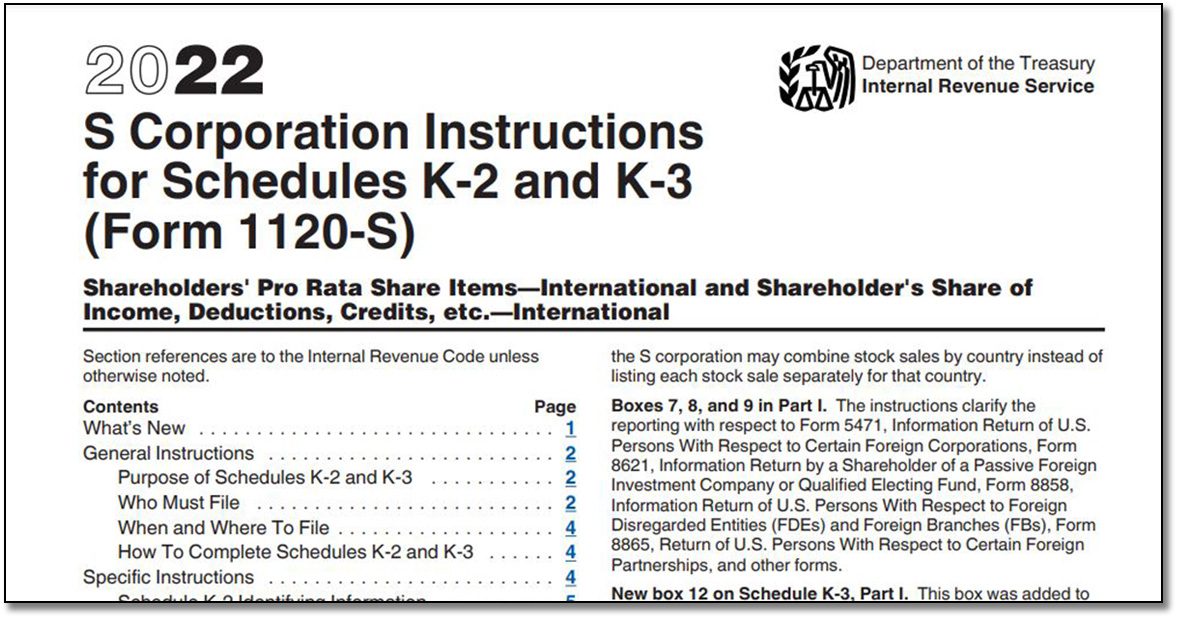Two Key Provisions of the SECURE 2.0 Act
The new SECURE 2.0 Act contains many provisions covering retirement plans, going beyond what was provided in the original SECURE Act. Passed in the last days of 2022, the…
January 30th, 2023

If you expect to prepare S corporation or partnership tax returns this year, you probably welcomed the language of draft instructions for Schedules K-2 and K-3. The instructions released in early December provided a procedure to avoid preparing these lengthy forms and the separate notification that permits this. It may not be clear how to implement the provisions of the IRS’s December instructions for your clients, though.
Professional Tax Institutes, Inc., a national order partner of the University of Illinois Tax School, has created a sample notification letter that you could send to your clients to assist in implementing these instructions. This notification is based on the draft Schedule K-2 and K-3 instructions recently issued by the IRS for preparing these schedules for tax years beginning in 2022.
Initially, the IRS stated a notification must be sent by the entity 60 days before the due date of the entity’s return. For a calendar year entity with a March 15 filing deadline, this would be January 15. Subsequently, the IRS added a one-month paragraph. This one-month paragraph mandates that the shareholder/partner who may need the Schedule K-3 must request it one month before the entity return deadline.
While that requirement still stands, the IRS has changed the instructions to include the extended filing deadline and eliminated the requirement for a separate written notification to the shareholders/partners to request Schedule K-3. As an alternative, S corporations and partnerships can include an attachment to Schedule K-1 advising recipients that no Schedule K-3 will be produced unless the shareholder/partner makes a request. The entity may use this procedure if it has no or limited foreign activity and all partners are U.S. citizens or resident aliens.
This language is provided for your consideration and may be useful in notifying shareholders or partners of business entity returns you are preparing. Please use your professional judgment in using it. You may wish to review the letter and the Schedule K-1 language with your attorney. We do not practice law and make no representations of their legal status or viability. These forms were developed based on the following final instructions.
Dear Shareholder/Partner:
New requirements from the Internal Revenue Service become effective with the preparation of your 2022 business tax return, Form 1120-S (or Form 1065 or Form 8865). Due to concern over the proper reporting of foreign source income, activity, and foreign taxes paid, Schedules K-2 and K-3 may be required to accompany the business tax return for a pass-through entity. The requirement for these forms is necessary if foreign source income within the business requires the payment or accrual of foreign taxes.
The instructions provide a Domestic Filing Exclusion in which Schedule K-2 and Schedule K-3 are not required to be filed because your business meets the exclusion’s requirements. Based on our review of your organization’s activities and management consultation, neither Schedule K-2 nor Schedule K-3 will be produced unless a shareholder/partner makes a request one month prior to the entity’s due date.
If a shareholder/partner requires the Schedule K-3 information from the business for preparing their individual returns due to claiming a foreign tax credit, they must notify the business tax manager, {individual’s name}, who must notify our firm no later than February 15, 2023.
Sincerely,
{Name of company officer}
{Title of company officer}
—————————-
Note. If the entity elects to extend the due date until September 15, 2023, then the deadline in the last paragraph needs to be changed to August 15, 2023.
Attachment XX to Schedule K-1
Per Internal Revenue Service instructions for Schedules K-2 and K-3, [Business entity name and FEIN] has met the criteria for the Domestic Filing Exclusion and is not required to produce these schedules.
Based on your organization’s activities and management consultation, we will not be producing Schedule K-2 or Schedule K-3 unless a {shareholder/partner} requests, in writing, to receive these schedules within {a defined period}.
—————————-
Note. All draft language is provided as information only. Each tax professional should perform their own research to verify requirements because draft instructions change frequently and are not yet final. Here’s an earlier Tax School blog post to reference that covers the basics of Schedule K-2, Climbing IRS Schedule K-2 When Preparing Taxes.
Authors:
Frances J. Coet, CPA, Professional Tax Institutes, Inc.
Ronald D. Powell, EA, Professional Tax Institutes, Inc.
John W. Richmann, EA, University of Illinois Tax School
Disclaimer: The information referenced in Tax School’s blog is accurate at the date of publication. You may contact taxschool@illinois.edu if you have more up-to-date, supported information and we will create an addendum.
University of Illinois Tax School is not responsible for any errors or omissions, or for the results obtained from the use of this information. All information in this site is provided “as is”, with no guarantee of completeness, accuracy, timeliness or of the results obtained from the use of this information. This blog and the information contained herein does not constitute tax client advice.
Join 1,400 of your colleagues and get notified each time a new post is added.